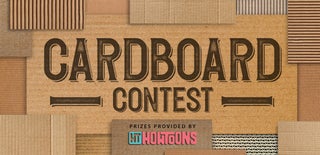Introduction: Fly CardBoard Airlines
As you know if you follow me or if you have read one of my previous I'tables, I love cardboard. So do my kids, but what they love the most is playing around with cardboard toys I make.
Lately they ask me if you could make cardboard flying... That was a great challenge. I found some I'tables about building planes out of cardboard but I rather made my own.
Objectives
My main objectives is to build a plane out of cardboard that flies, first, and then is beautiful while insuring a lot of fun for the kids.
Oh yes I wanted also this plane to be "2 and 5 years old kids" compliant ;-)
What you will need
As usual with cardboard projects, you will need
- printer (to print the pattern)
- an utility knife
- a cutting mat
- hot glue gun (optional)
- duct tape
- rubber bands
- ruler
- pen
Let's discover what we ended with ;-)
Step 1: Design
I draw it by hand on a A3 paper. That's one of my favorite challenge. Making my designs available on A3 sized paper because most of us don't have larger printers (even A3 printers are not so common) and also because most of the delivery cardboard boxes have a A3 sized side.
So I draw it on a paper, scanned it and then post-proceed the file in Illustrator and Fusion360. I have made several prototypes to see the "flyability" and the making process (some are in the photos of this I'bles). As for an example of the interest of making prototypes (even work, believe me), here are some lessons learned I gathered:
- Corrugation direction should be taken into account first for "flyabiltiy"* and then for durability
- Extra weight should be added on then nose area to better fly (obvious when said...)
- Larger and bigger wings would help fly longer (idem)
- We have to go back to physics when trying to make something fly
The final design is attached as PDF files. One can report the pattern on cardboard, glue the pattern on cardboard and cut or laser cut it. My PDF files are always laser cut friendly ;-)
*see the "Back to physics step"
Step 2: Building the Planes
As I have 2 kids and I want as peaceful afternoon as possible, I built 2 planes.
Print the available PDF* and transfer it to your cardboard according to one of my 2 favorite techniques:
- gluing the pattern on the cardboard
- transferring the pattern using a pen or even better a sharp knife.
Cut the parts.
Glue the nose's parts together to reinforce this area which will be the most endangered one because our pilot doesn't really master the landings ;-)
Don't mount the wing now because we need to go Back to Physics first!
Hint from the field
You only have a A4 or US letter size printer? Check the available printing options. Most of the printers have now an option called "Print on several pages" or equivalent. It will print the pdf on several pages (as said), then you just have to reassemble them to get the original size. As my file is A3, you will have only 4 A4 pages
Step 3: Back to Physics (just a Little)
Things like planes are flying because there is a difference in the speed of the air flow over and under the wings creating a pressure drop. This pressure drop makes the plane fly.
On my plane I had 2 issues to deal with:
- My wing is squared and flat so no speed difference possible. I tried to create one but pressing on the back part of my wing, don't know if it helps but, well, I did it.
- The opened corrugations on the wing allowed the air to get through the wing. I fixed that by duct taping the front face of the wing.
In addition, I added an little angle of attack on my wing in order to achieve a better flight. To do so, I added a little angle to the hole that serves to assemble the body and the wing. But don't worry, it is already done in the pattern you downloaded.
Now you can mount the wing. Take care not to damage your plane. Engage the wing in its location and then pull it. It should be tight so if not you can hot glue it but just a little to avoid adding to much unbalanced weight.
If necessary you can also add a coin on the nose to add more weight in this particular area. It will enhance the fly experience.
Step 4: 3, 2 ,1: Ignition (Final Result)
I needed a launching system in order to maximize fun.
Take your rubber band and bend it between two fingers.
Place your plane and ... ready, set.. go...!
Let it fly! (Yes, it flies!)

Participated in the
Cardboard Contest 2017












